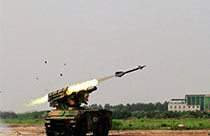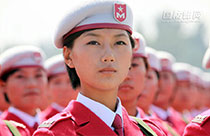

III. The Political System Suited to China's Actual Conditions
Implementing the system of regional ethnic autonomy in Tibet conforms to China's reality as a unified multiethnic country.
China is a unified multiethnic country inhabited by 55 minority ethnic groups, including the Mongolian, Hui, Tibetan, Uygur, Zhuang, Korean, and Manchu, in addition to the Han ethnic group. The Chinese nation is a big, pluralistic and integrated family whose constituent ethnic groups have all contributed to national development and cultural innovation. The origins and development of China's ethnic groups are indigenous, pluralistic and diverse. All have formed and evolved in different ways, yet in the general trend, have developed into a unified multiethnic country and converged into the unified and stable Chinese nation. As early as the pre-Qin period, Chinese ancestors developed the concepts of "world" and "grand unification." In 221 BC, the Qin Dynasty (221-206 BC) realized the first unification in history of China, and established prefectures and counties to rule the country. The central government of the Han Dynasty (206 BC- AD 220) and subsequent dynasties developed and consolidated China's unified multiethnic pattern. Despite the brief separatist regimes and regional splits that have occurred in Chinese history, unification has always been the mainstream and direction of national development.
Ever since ancient times, Tibet has been an integral part of China, and the Tibetan ethnic group has been a communal member of the Chinese nation sharing a common destiny. The ancestors of the Tibetan and other ethnic groups who lived on the Tibetan Plateau in ancient times established extensive contacts with China's inland, and made significant contributions to the formation and development of the country. From the 13th century, when the Yuan Dynasty (1271-1368) included Tibet under its central administrative jurisdiction, to the time before 1949 when the People's Republic of China was founded, the central governments of all dynasties in China ruled Tibet as part of the country. On this footing, they adopted special policies for Tibet, taking into account the "special local customs and conditions," and adopted an administrative structure and governance approaches that were distinct from those in other parts of China.
In the Yuan Dynasty (1271-1368), the central government established the Supreme Control Commission of Buddhism (later renamed the Commission for Buddhist and Tibetan Affairs), and set up in Tibet the Chief Military Command under the Pacification Commissioner's Office to directly manage the region's political and military affairs. The Yuan court stationed troops in Tibet, and set up 13 organs, including the 10,000-man Brigades and 1,000-man Battalions under the Pacification Commissioner's Office. The Yuan court set up courier stations on the road leading from Tibet to the capital city of Dadu, and sent officials to Tibet three times to conduct census. Emperor Shizu of the Yuan Dynasty, Kublai Khan, appointed Phagpa from the Sakya School of Tibetan Buddhism as Imperial Preceptor. Later, when the Kagyu School replaced the Sakya School, Emperor Shundi appointed the Kagyu leader Changchub Gyaltsen "Ta Situ."
The Ming Dynasty (1368-1644) generally followed the Yuan administrative system for Tibet. Politically, the Ming court implemented a policy of multiple enfeoffment, conferring the titles "Prince of Dharma" and "Imperial Empowerments Master" upon religious leaders in Tibet; economically, it promoted the tea-horse trade to increase Tibet's trade and exchanges with other regions; in terms of organizational structure, it established the u-Tsang Regional Military Commission in today's central Tibet and the Do-kham Regional Military Commission in eastern Tibet, both subordinated to Shaanxi Regional Military Commission, and the Ngari Commanding Tribal Office in western Tibet.
In the Qing Dynasty (1644-1911), the Court of Tribal Affairs (later the Ministry of Tribal Affairs) took charge of Tibetan affairs. In 1653 and 1713, the Qing emperors conferred the Dalai Lamas and Panchen Erdenis of the Gelug School of Tibetan Buddhism that appeared in the late Ming Dynasty, and established the system of lot-drawing from the golden urn to confirm the reincarnated soul boy of a deceased Living Buddha. In 1727, the Qing government started to station grand ministers resident in Tibet. In 1751, Emperor Qianlong appointed the Seventh Dalai Lama to administer the local government of Tibet, established the Kashag (cabinet) composed of four Kalons (ministers). In 1793, Ordinance by the Imperial House Concerning Better Governance of Tibet (the "29 Articles") was promulgated to enhance the Qing court's administration of Tibet.
The central government continued to exercise sovereignty over Tibet during the Republic of China period (1912-1949). In 1912, the central government established the Bureau of Mongolian and Tibetan Affairs (renamed the Mongolian and Tibetan Affairs Yuan in 1914) to replace the late Qing's Ministry of Tribal Affairs, and dispatched the commissioner resident in Tibet to exercise the functions and power of the grand minister resident in Tibet. In 1929, the nationalist government established the Mongolian and Tibetan Affairs Commission to exercise administrative jurisdiction of Tibet. In 1940, the nationalist government set up the Tibet Office of the Mongolian and Tibetan Affairs Commission in Lhasa. The Organic Law of the Congress of the Republic of China stipulated the methods whereby the people of Tibet would participate in elections, and the rights of elected congressmen from Tibet to directly participate in deliberation and administration of state affairs. The identification and enthronement of both the 14th Dalai Lama and the 10th Panchen Erdeni were approved by the government of the Republic of China.
Since its birth in 1921, the CPC has supported ethnic equality and unity in China, vigorously exploring the path through which to achieve ethnic equality and resolve ethnic issues. Since the founding of the PRC in 1949, the Chinese government has promoted equality, unity, mutual support, fraternity, and common development and prosperity among all ethnic groups as fundamental principles under which to address ethnic issues and relations. Taking into consideration China's history and social conditions in modern times, the PRC did not choose the composite system (also known as the federal system) for its state structure, but the unitary system instead; it decided to exercise regional ethnic autonomy in areas inhabited by minority ethnic groups under unified state leadership, thus to ensure that ethnic minorities enjoy the rights of being masters of the country.
Regional ethnic autonomy is the correct choice for China, a unified multiethnic country, to address ethnic issues and relations. China's regional ethnic autonomy is a form of autonomy under unified state leadership. All ethnic autonomous areas are inseparable from the country, and the organs of self-government of all ethnic autonomous areas shall be subject to the central government's leadership.
The regional ethnic autonomy system is also a significant component of China's socialist system. Under the socialist system, all power belongs to the people, and the state safeguards the democratic rights of the people. All autonomous areas exercise the power of autonomy in their economic, political, cultural, social, and ecological development, and in managing their regional affairs. This exemplifies the exercise of socialist democracy in regions inhabited by ethnic minorities.
Through the peaceful liberation in 1951 and the democratic reform in 1959, Tibet Autonomous Region was founded in 1965, so officially establishing the system of regional ethnic autonomy in Tibet. The exercise of this system in Tibet has combined unification and autonomy, taking into account both ethnic and regional factors. This system inherits historical traditions and signifies socialist democracy; it conforms to the historical traditions of Tibet and the whole country, as well as to the common will and fundamental interests of the people of all ethnic groups.
Currently, the People's Congress and the People's Government of Tibet Autonomous Region are organs of self-government as well as local organs of state power through which to implement state laws and policies based on local reality. Through several decades of exploring the path of regional ethnic autonomy, the people of all ethnic groups in Tibet Autonomous Region have achieved equality, unity, mutual support and harmony, and the system of regional ethnic autonomy has won the wholehearted support of all ethnic groups in China.
 |  |
 'Enemy planes' intercepted by Hongqi-7B air-defense missiles
'Enemy planes' intercepted by Hongqi-7B air-defense missiles Blind date with bikini girls in Nanjing
Blind date with bikini girls in Nanjing Amazing photos of Chinese fighter jets
Amazing photos of Chinese fighter jets Chinese soldiers participate in training for V-Day parade
Chinese soldiers participate in training for V-Day parade Painting: Lonely women in Forbidden City
Painting: Lonely women in Forbidden City China and Russia hold joint drill in Sea of Japan
China and Russia hold joint drill in Sea of Japan 'Goddess' in Taiwan McDonald's
'Goddess' in Taiwan McDonald's Female soldiers at military parades
Female soldiers at military parades Photos of campus belle doing splits go viral
Photos of campus belle doing splits go viral Best blade forward
Best blade forward Infographic: Parsing China's massive V-day parade
Infographic: Parsing China's massive V-day parade Giant panda cub receives medical care in Guangzhou
Giant panda cub receives medical care in Guangzhou China celebrates 70th Anniversary of Victory of World Anti-Fascist War
China celebrates 70th Anniversary of Victory of World Anti-Fascist WarDay|Week